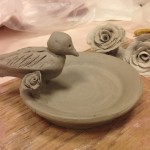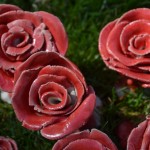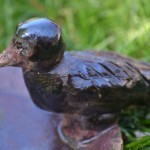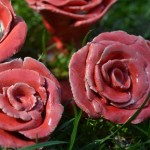Reflections of my Nightingale
When reading the dustcover of Farid Attar’s Conference of the Birds, its description reads: “Composed in the twelfth century in north eastern Iran, Attar’s great mystical poem is among the most significant of all works of Persian literature.” I misinterpreted the value of reading this piece, thinking, how was I supposed to connect with a work so foreign, so different from anything I had ever read? Words like “mystical,” “Persian” and “twelfth century” made me doubt its relevance to my own life. I was amazed that despite my initial skepticism, I was able to connect with this work in a profound way. Through this poem about birds, I encountered what it means for a work to be timeless, universal and to transcend boundaries. I was so drawn to characteristics in its birds that I saw in myself, that I decided to make a clay nightingale and rose birdbath as one of my creative projects.
The hoopoe speaks to the birds, encouraging the need for them to seek the Simorgh as their new king. At first the whole assembly of birds are positive and “all rose impatient to be on the wing; each would renounce the self and be the friend of his companions till the journey’s end.”[1] However as the perils and challenges of the journey become apparent, the birds’ resolve weaken, and Attar uses this to explore different human vices. I most closely associated with the nightingale. He is so caught up in the rapture and obsession of his love for the rose, that the thought of leaving, even to find the Simorgh, cannot be tolerated. He declares that “my love is for the rose: I bow to her; from her dear presence I cannot stir.”[2] He wants nothing more from life and “her worship is sufficient life for me; the quest for her is my reality.” [3] I feel that in life I too sometimes become obsessed with a project, that I have passionate bouts of enthusiasm for things that are short lived. The hoopoe advisers the nightingale that his love for the rose is a “superficial love which makes you quail” and that it is an empty love that is but a “fleeting turbulence”[4] which will quickly fade.
At the end of their journey the birds arrive at the dwelling place of the Simorgh, “thirty exhausted, wretched things.”[5] Yet instead of encountering a Simorgh who will rule over them all, the Simorgh is “a mirror set before your eyes, and all who come before My splendour see themselves and their own unique reality.”[6] They learn the great insight that “’we’ is not distinguished here from ‘you.’”[7] In my initial distancing myself from the poem, I made the same mistake as the birds. I couldn’t see my reality in the distant realm of Attar. Through my reading of the book I too learned how my existence is reflected in unlikely places. This idea of reflection and “mirroring” was the reason that I made my nightingale rest on a bird bath. I am hoping that through his contemplation of his reflection he will be able to leave behind the absurdities of his rose and follow the Simorgh’s advice: “You find in Me the selves you were before.”[8]
[1] Farid Attar, “The Conference of the Birds” (London: Penguin Classics, 2011), 45.
[2] Attar, “The Conference of the Birds,” 46.
[3] Attar, “The Conference of the Birds,” 46.
[4] Attar, “The Conference of the Birds,” 46.
[5] Attar, “The Conference of the Birds,” 230.
[6] Attar, “The Conference of the Birds,” 234.
[7] Attar, “The Conference of the Birds,” 235.
[8] Attar, “The Conference of the Birds,” 235.








